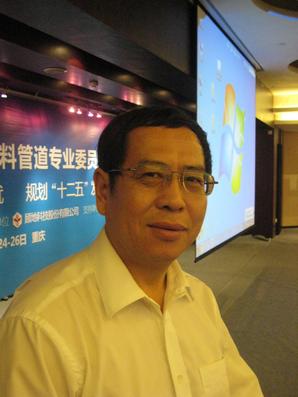Published: September 6, 2013 1:53 pm ET
Updated: September 6, 2013 1:56 pm ET

Image By: Steve Toloken
Wang Zhan Jie, China Plastics Piping Association secretary general
XI'AN, CHINA — China's PVC pipe manufacturers, which are among the industry's biggest users of lead-based additives, are coming under pressure to phase out the heavy metal in favor of more environmentally-friendly stabilizers.
Industry estimates say that lead is the stabilizer of choice in more than 90 percent of China's PVC pipe applications. But at a recent industry conference in Xi'an, the country's leading plastic pipe trade group and some industry companies were pushing for China to join some other countries and phase out lead.
The Beijing-based China Plastics Piping Association, for example, adopted a policy to encourage companies to eliminate lead by 2015, mirroring a voluntary commitment by the European vinyl industry.
Chinese national standards in 2006 banned lead stabilizers in PVC pipes used in water supply. But some industry officials say lead, which damages the brain and nervous system, is still fairly widely-used in water pipe, in addition to being used in other applications.
That's because alternatives are more expensive, lead sometimes performs better and, so far at least, the government has not taken strong action, according to interviews at the 2013 International Plastic Pipe Exchange Conference, held Sept. 5-6 in Xi'an.
One company supplying non-lead stabilizers, Gaoke Building Materials (Xinyang) Pipe Technology Co. Ltd., told the conference that the move away from lead stabilizers should speed up after a joint announcement in June by the Supreme People's Court and the Supreme People's Procuratorate on criminal prosecution for environmental polluters.
That decision "is a wake-up call to the enterprises that use heavy metal compounds such as lead and cadmium in the manufacturing process," Xi'an-based Gaoke said in a paper delivered to the conference. "Therefore, pushing forward the non-lead manufacturing process of PVC products becomes an inevitable trend in this industry."
CPPA last year formally proposed that the PVC pipe industry stop using lead by 2015, according to Wang Zhan Jie, secretary general of the group.
He said there's rising concern among the public in China about lead contamination, and he called it an "irresistible" trend to eliminate lead in PVC processing.
Wang said the performance of non-lead stabilizers like calcium zinc and tin have improved greatly in recent years. Still, he also told the conference that companies sometimes question whether giving up lead would make their pipes less stable.
China's PVC pipe industry is not alone in using lead, particularly in the developing world.
Lead is used in 95 percent of PVC pipe in India, 86 percent in the Middle East and Africa, and 61 percent in South America, according to figures from German stabilizer maker Baerlocher GmbH, presented at the conference.
In Europe, by contrast, 29 percent of all PVC pipe systems use lead, while in North America, the figure is less than 1 percent, because nearly 100 percent of vinyl pipe systems use tin as a stabilizers, Baerlocher said.
Europe's PVC industry has committed to eliminate lead by 2015, and has eliminated lead stabilizers in 80 percent of its applications, according to Rainer Grasmuck, chairman of PVC 4 Pipes, a pan-European trade association and an executive at Baerlocher, in an interview at the conference.
In China, however, it's not clear if the industry can meet the same 2015 commitment.
One PVC pipe maker said it remains common for the water supply industry to use lead-based stabilizers in China, even with the 2006 standards banning them in that application.
Deric Lee, business manager for Hongyue Plastic Group Co. Ltd., in Qinhuangdao, Hebei province, said "indeed, a lot" of PVC water pipe makers in China use lead stabilizers. He said his company uses calcium-zinc stabilizers and not lead, and as a result its products are more expensive.
"A lot of customers ask us to produce the pipe with lead because that can bring the cost lower," said Lee, in an interview at his company's booth at the conference. "Our price is higher than the competitors but we think we need to insure a good quality."
He said the company has regular customers who do not want them to use lead. The firm, which employs more than 600 people, has 150 extrusion lines and 150 molding machines, and opened its third factory last year, an indication that the focus on better quality is working, he said.
Industry statistics lend support to the idea that lead is still used in water supply piping.
Data from the CPPA said that 30 percent of China's PVC pipe is used in water supply (not including drainage applications), but statistics from Baerlocher estimate that 91 percent of China's PVC pipe market uses lead stabilizers.
That would suggest that some significant percentage of water pipes would still be made with lead.
Baerlocher said it sees some momentum in China to move away from lead, and last year opened a plant in Changzhou making calcium zinc stabilizers, said Grasmuck, who is the company's head of SBU PVC Additives for Asia and Americas.
Still, there are challenges, he said: "There is some hesitation to change to calcium zinc — lead is cheaper and easier to process."
Most of the movement away from lead in Asia's PVC pipe industry has been in South Korea, Australia and New Zealand, and Asia in general remains dominated by lead, said Udo Anders, technical product manager for Baerlocher: "There exists … no real regulations."
Hongyue's Lee agreed, and said there seem to be few if any negative consequences with authorities for competitors using lead: "The government didn't say anything."
China's pipe industry wants to move away from lead but one limitation is a lack of technical skills to efficiently work with the alternatives, according to Chen Zhi, a research and development engineer with pipe maker Wuhan Kingbull Economic Development Co. Ltd.
The conference was organized by the CPPA, with support from the Plastics Pipe Institute in the United States, PVC 4 Pipes, the Netherlands-based PE100+Association, the European Plastic Pipes and Fitting Association and the China Plastics Processing Industry Association. | 